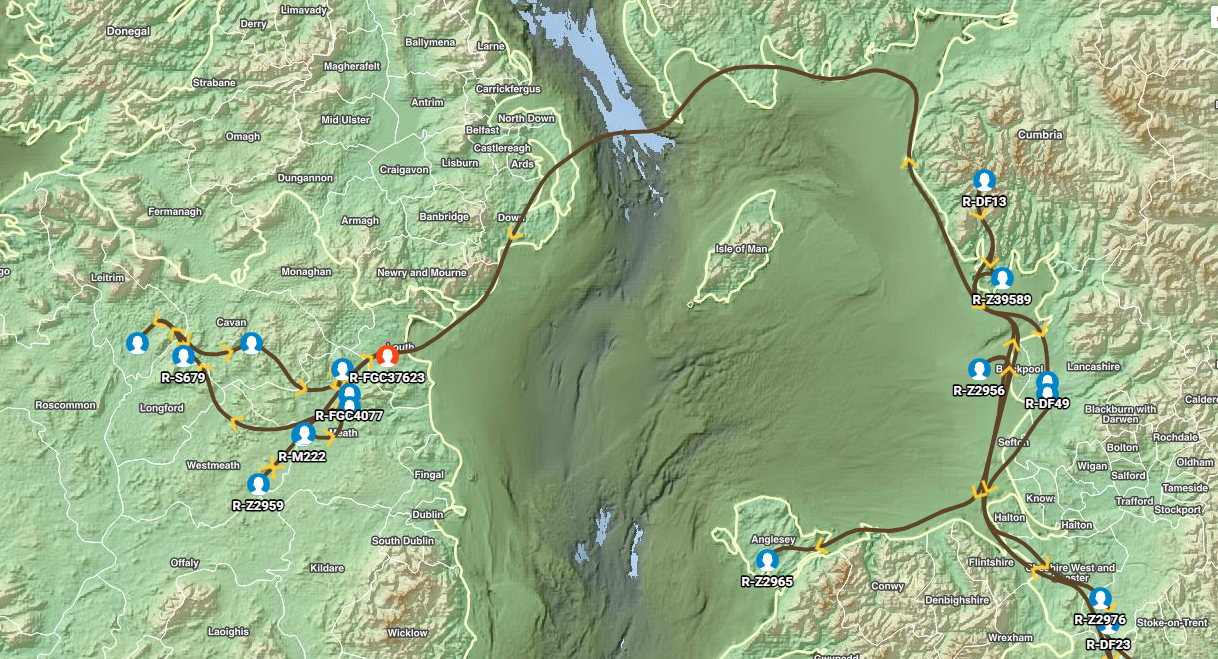The Genetic Genealogy of the Hoy Family

The path of the genetic lineage of the Hoy Family
The image on the left (click for a larger view), is from the FamilyTreeDNA genetic testing company. FTDNA uses archaeological remains and user-reported ancestral locations to plot the locations of their tested SNPs through time and across the landscape.
Our line is traced back to the first R man who lived in Siberia around 22,000 BC. A part of his population went east and joined another group and the new group crossed the Bering Land Bridge to America where they became the Native American Indian peoples, but without any R-DNA traces. The rest moved south and eventually split into R1a and R1b and made their way to the Eurasian Steppe above the Black and Caspian Seas where they acquired horses, wheeled vehicles, bronze weapons, and the Indo-European languages. Around 3500 BC, R1a and R1b moved west and became the dominant Y-DNA lines in Europe. R1a east of the Rhine and R1b west.
The map is centered on the Irish Sea with the Isle of Man in the middle. The path picks up in the lower right near Anglesey in Wales and Stoke on Trent in England and goes north through Scotland before crossing into Ireland in County Down. The red circle at the end corresponds to James Hoy of County Louth born around 1800. (The path actually picks up at DF13 and does a loop down and then back up.)
Our full line from R to James is below, but it is M222 which is of most interest to us and our possible connection to the La Tène culture in Ireland.
R-M207>M173>M343>L754>L761>L389>P297>M269>L23>L51>P310>L151>P312>Z290>L21>S552>DF13>Z39589>DF49>Z2980>Z2976>DF23>Z2961>Z2956>Z2965>M222>Z2959>BY35297>FGC4077>A725>S676>S679>FGC37618>FGC37613>FGC37623
FTDNA places M222 in Ireland very near to the Hill of Tara in County Meath around 100 BC. The part of the Tara enclosure at Ráth na Rí is dated to about the same time and the Mound of the Hostages within it contains unusual earthworks very similar to the figure-of-eight structures at Dun Ailinne of the Laighin in Kildare and Emain Macha of the Ulaidh in Armagh. Earthworks at Emain, the Dorsey, 20 miles south of it, and the nearby section of the Black Pig's Dyke are all dated to 94 BC by dendrochronology (tree rings).
So we have 100 BC for:
- M222
- Tara
- Emain Macha
- Black Pig's Dyke
- The Dorsey
Francis J Byrne in his book 'Irish Kings and High Kings', notes this:
- Bhí trí phríomhchinéal in Éirinn, .i. Féini agus Ulaidh agus Gáilni, .i. Laighin.
- There were three primary kinships in Ireland, i.e., the Féini and Ulaidh and Gáilióin, i.e., the Laighin.
The La Tène culture in Ireland
The spread of the La Tène culture into Ireland occurred at the same time as the M222 arrival in Ireland and was predominantly in the areas that the the Féini, the Ulaidh, and the Laighin controlled.
Haplogroup Age Estimates- R-FGC37623: 1800 AD
- R-FGC37613: 1200 AD
- R-FGC37618: 1050 AD
- R-S679: 950 AD
- R-S676: 800 AD
- R-A725: 400 AD
- R-FGC4077: 300 AD
- R-BY35297: 100 AD
- R-Z2959: 50 BC
- R-M222: 100 BC
- Byrne, Francis John (2001), Irish Kings and High-Kings, Dublin: Four Courts Press, ISBN 978-1-85182-196-9
- Brian Patrick McEvoy, First published 2005, Genetic investigation of Irish ancestry and surname history
- James McNish, First published 22 February 2018, "The Beaker people: a new population for ancient Britain", The beaker-people a new population for ancient Britain
- Lara M. Cassidy et al, First published December 28, 2015, "Neolithic and Bronze Age migration to Ireland and establishment of the insular Atlantic genome", Cassidy et al
- Davidski - Eurogenes Blog, Wednesday, January 16, 2019, "Single Grave > Bell Beakers", Single Grave Bell-beakers